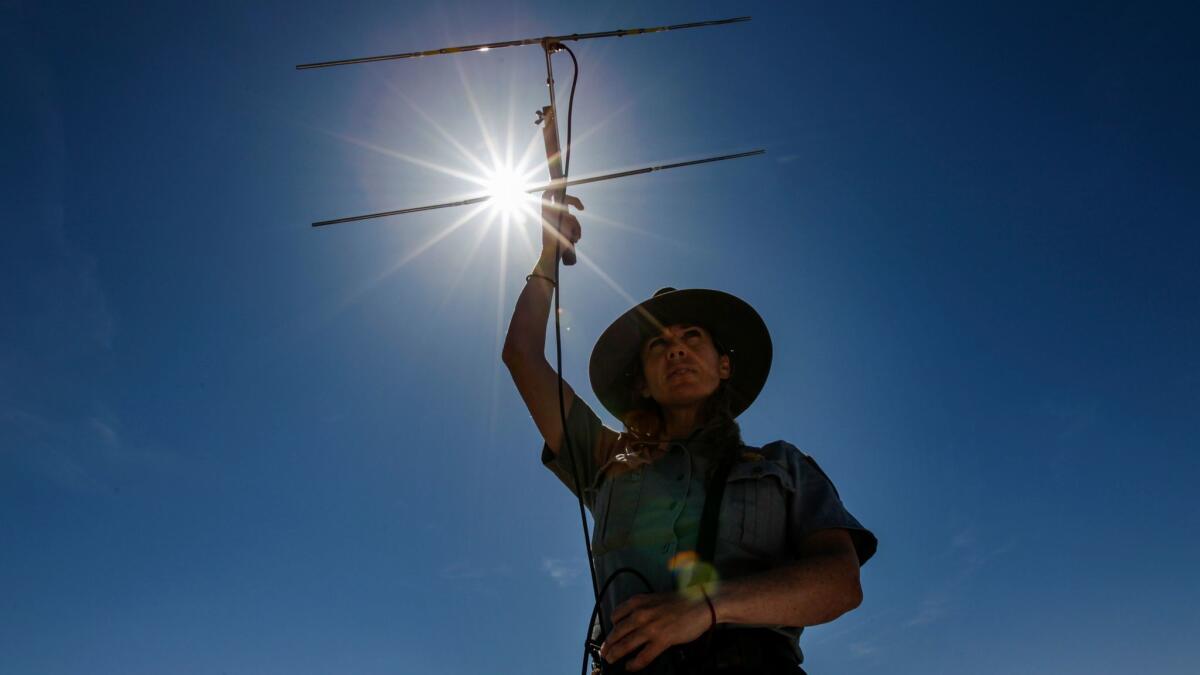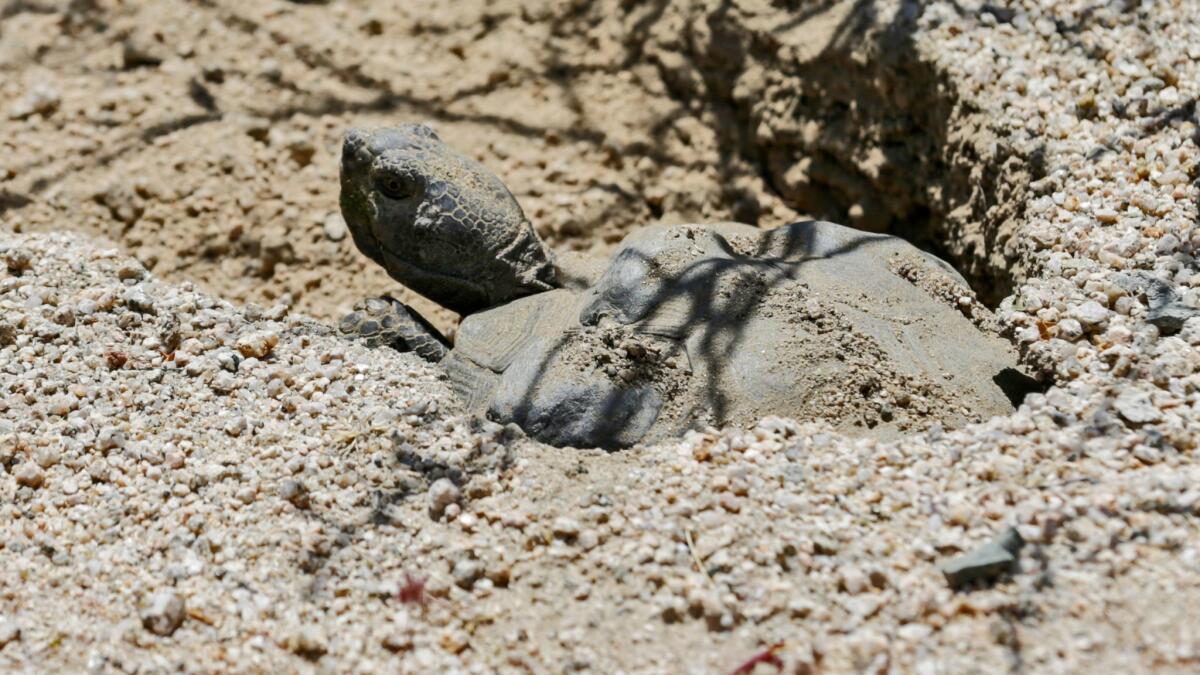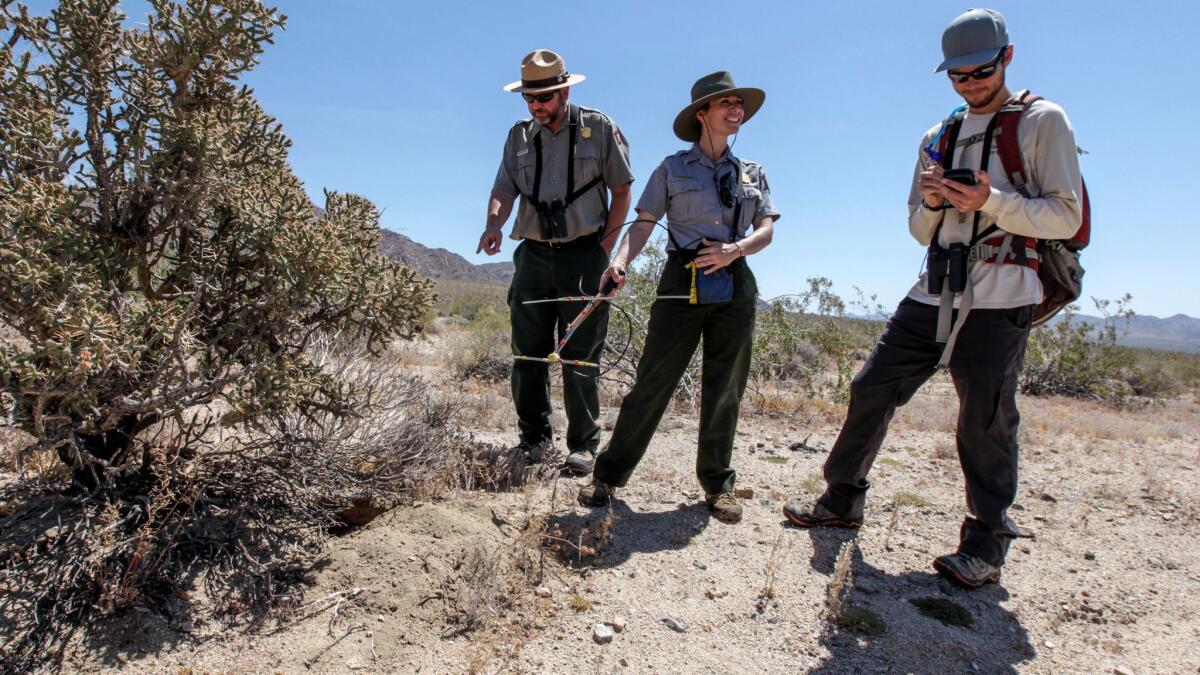An ‘evolutionary gamble’ may be killing Joshua Tree’s mother tortoises

Over the last three decades, the park’s tortoise population has plummeted from roughly 30,000 to an all-time low of about 3,000.
Reporting from Joshua Tree National Park, Calif. — Wildlife biologists say an alarming number of female desert tortoise carcasses found earlier this year just outside the southern edge of Joshua Tree National Park may be the result of mothers fighting extinction by exhausting their water and energy to lay eggs, even under stress.
U.S. Geological Survey biologist Jeffrey Lovich, who has monitored tortoises in and around the park for two decades, said the potentially lethal response to prolonged drought may become more common throughout the Southern California desert as temperatures rise and forage diminishes.
“This is still a hypothesis,” Lovich said on Monday, “but I believe these tortoises died after continuing to lay clutches of four eggs the size of ping pong balls year after year, using up vital resources they need to survive.”
“It was an evolutionary gamble,” he said. “If it pays off, their genetic information will be passed on to a new generation of hatchlings in conditions more suitable for survival of the species.”
Single female seeks relationship with strong male... Must enjoy flowers, long slow walks and cuddling up in desert caves.
— Kristen Lalumiere, biologist

A research team led by Lovich was surveying a study area of several square miles on the northern flanks of the Orocopia Mountains when it discovered the remains of 14 female and three male tortoises, and 15 live animals, most of them males.
Judging from the deterioration of the carcasses and chalkiness of the bones, Lovich concluded the animals perished over the last five to 10 years, a period including five consecutive years of drought regarded as the most severe in recorded history.
The find has stepped up concerns over the fate of tortoises within the nearly 800,000-acre national park, which recent rains made into a showcase of habitat, lush with plants and flowers for the lumbering reptiles to fatten up on.
But vast swaths of terrain carpeted with daisies can only do so much, biologists say, in the face of longer droughts and climate change.
Despite its name, scruffy body armor and status as a symbol of the desert conservation movement, the tortoise is not well adapted to arid landscapes. It evolved thousands of years ago, when the region was cooler and dominated by lakes and marshes fringed with Joshua trees and junipers, Lovich said.
Over the past three decades, the park’s tortoise population has plummeted from roughly 30,000 to an all-time low of about 3,000, Michael Vamstad, a wildlife ecologist at the park, said.
A federal analysis determined that a viable population of tortoises must maintain an average minimum density of about 10 adults per square mile. The average density within the park today is about nine adults per square mile, Vamstad said.
“We’re at a point now where we expect tortoises to disappear in certain areas because there aren’t enough of them around to find a mate,” he said. “But we believe there will also be pockets with the right combinations of air temperature, moisture and forage to sustain tortoises for years to come.”
I believe these tortoises died after continuing to lay clutches of four eggs the size of ping pong balls year after year.
— Jeffrey Lovich, biologist

Over the past century, desert tortoises have been decimated by habitat loss, trampling by cows and sheep, shootings, vehicle strikes, disease, collecting, relocation efforts on military bases and predation by ravens, coyotes and dogs.
Now their deadliest foe is climate change, which is upsetting the delicate balance of life and death conditions for the species in an otherwise intensely managed expanse of habitat within a national park.
“The recent five-year drought is a window into the future of what climate change may look like across the Southwestern United States,” Cameron Barrows, a UC Riverside ecologist who specializes in the park’s wildlife, said. “In certain study plots where we found lots of tortoises even two years ago, we didn’t find any this year.”
Improving the odds of survival for tortoises hasn’t been easy at a time when record numbers of tourists are straining park roads, campsites and services, officials said. The park had 2.5 million visitors in 2016, twice the number seen five years ago, officials said.
In the midst of a spectacular wildflower bloom in March that attracted both hungry tortoises and a crush of camera-toting tourists, three tortoises were struck and killed by cars in a single week.
Officials are considering roadside fencing, which is effective in reducing mortalities of tortoises and other reptiles. It is also controversial, however, because it is expensive to install and maintain, fragments habitat and is an eyesore on federal lands set aside for their natural beauty.
“Climate change has no regard for traffic signs, speed limits, roadside barriers or national park boundaries,” said Debra Hughson, a research biologist at the Mojave National Preserve, about 50 miles northwest of the park.

It’s not all bad news.
Under a hot morning sun on a recent weekday, park biologist Kristen Lalumiere followed telemetry pings across a desolate arroyo edged with cholla cactus to a radio-collared female desert tortoise the size of a volleyball emerging from a burrow to bask in the sunshine, dine on flowers and, perhaps, find a mate.
Lalumiere peered inside, then smiled and said, “You’re looking good, girl -- clear eyes, clean nose and flower stains all over your mouth.”
Adding a hopeful dose of anthropomorphism, she said, “Single female seeks relationship with strong male willing to fight to protect her. Must enjoy flowers, long slow walks and cuddling up in desert caves.”
The tortoise biologists dubbed “Salsa Verde” stared back at her, then retreated into her burrow.
In a nearby burrow, a male tortoise known as “Scuter” was taking a siesta.
Whether or not they produce a new generation of tortoises will not be known for 15 to 20 years because that is how long it takes hatchlings to reach maturity, even in the best of times.
Click here for a Spanish version of this story
ALSO
Meet the City Council aide who’s become the ‘Superman’ of cleaning up illegal dumping
Bear is euthanized after wandering onto 210 Freeway, getting struck by vehicle
Shark advisory remains in effect in waters off Long Beach
More to Read
Sign up for Essential California
The most important California stories and recommendations in your inbox every morning.
You may occasionally receive promotional content from the Los Angeles Times.











